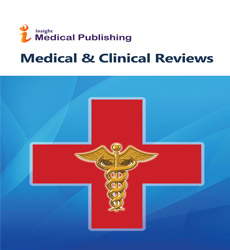The Industrialisation of Molecular Biology Assay Tools Has Made It Practical to Use Them in Clinics
Massimiliano Cadamuro*
Published Date: 2025-01-20Massimiliano Cadamuro*
Department of Computer Science, Stanford University School of Engineering, Stanford, United States
- *Corresponding Author:
- Massimiliano Cadamuro
Department of Computer Science,
Stanford University School of Engineering,
Stanford,
United States;
Email:Cadamuro@1234gmail.com
Received: September 25, 2023, Manuscript No. IPMCR-23-17943; Editor assigned: September 27, 2023, PreQC No. IPMCR-23-17943 (PQ); Reviewed: October 11, 2023, QC No. IPMCR-23-17943; Revised: January 03, 2025, Manuscript No. IPMCR-23-17943 (R); Published: January 10, 2025, DOI: 10.36648/2471-9838.11.1.180
Citation: Cadamuro M (2025) The Industrialisation of Molecular Biology Assay Tools Has made It Practical to Use them in Clinics. Med Clin Rev Vol: 11 No:1
Description
Sub-atomic diagnostics is an assortment of methods used to break down organic markers in the genome and proteome, and how their cells express their qualities as proteins, applying subatomic science to clinical testing. In medication the procedure is utilized to analyze and screen illness, recognize risk, and conclude which treatments will turn out best for individual patients, and in rural biosecurity also to screen yield and animal’s sickness, gauge risk, and conclude what quarantine measures should be taken.
By breaking down the points of interest of the patient and their sickness, atomic diagnostics offers the possibility of customized medication. These tests are valuable in a scope of clinical strengths, including irresistible sickness, oncology, human leucocyte antigen composing (which researches and predicts resistant capability), coagulation, and pharmacogenomics the hereditary forecast of which medications will work best. They cross-over with clinical science (clinical trials on organic liquids).
The field of atomic science filled in the late 20th hundred years, as did its clinical application. In 1980, Yuet Wai Kan, et al., proposed a pre-birth hereditary test for Thalassemia that didn't depend upon DNA sequencing then in its early stages however on probation catalysts that cut DNA where they perceived explicit short successions, making various lengths of DNA strand contingent upon which allele (hereditary variety) the hatchling had during the 1980’s, the expression was utilized in the names of organizations, for example, sub-atomic diagnostics consolidate and Bethseda exploration laborites atomic diagnostics.
During the 1990’s, the distinguishing proof of newfound qualities and new methods for DNA sequencing prompted the presence of a particular field of sub-atomic and genomic research facility medication; in 1995, the Relationship for Atomic Pathology (AMP) was framed to give it structure. In 1999, the AMP helped to establish the diary of clinical diagnostics. Informa medical services sent off master audits in clinical diagnostics in 2001. From 2002 onwards, the Hap Map undertaking amassed data on the one-letter hereditary contrasts that repeat in the human populace the single nucleotide polymorphisms and their relationship with sickness. In 2012, sub-atomic demonstrative procedures for thalassemia utilize hereditary hybridization tests to distinguish the particular single nucleotide polymorphism causing a singular's illness.
As the business use of sub-atomic diagnostics has become more significant, so has the discussion about protecting of the hereditary disclosures at its heart. In 1998, the European Association's Mandate 98/44/ECclarified that licenses on DNA arrangements were permissible. In 2010 in the US, AMP sued Horde Hereditary qualities to challenge the last option's licenses in regards to two qualities, BRCA1, BRCA2, which are related with bosom disease. In 2013, the U.S. High Court to some extent concurred, deciding that a normally happening quality succession couldn't be protected.
The industrialisation of sub-atomic science measure devices has made it pragmatic to involve them in facilities. Scaling down into a solitary handheld gadget can carry clinical diagnostics into the facility and into the workplace or home. The clinical research facility requires elevated expectations of unwavering quality; diagnostics might require authorization or fall under clinical gadget guidelines. Starting around 2011, a few US clinical labs in any case utilized measures sold for "research utilize as it were".
Lab processes need with comply with guidelines, for example, the Clinical lab improvement revisions, health care coverage compactness and responsibility act, great lab practice, and food and medication organization particulars in the US. Research center data the board frameworks help by following these cycles guideline applies to both staff and supplies. Starting around 2012, twelve US states require atomic pathologists to be authorized; a few sheets, for example, the American leading body of clinical hereditary qualities and the American leading group of pathology confirm technologists, managers, and research center chiefs.
Computerization and test barcoding boost throughput and lessen the chance of blunder or pollution during manual dealing with and results revealing. Single gadgets to do the examine from start to finish are currently accessible. Sub-atomic diagnostics involves in vitro natural tests like PCR-ELISA or Fluorescence in situ hybridization. The examine recognizes a particle, frequently in low focuses, that is a marker of illness or chance in an example taken from a patient. Conservation of the example before investigation is basic. Manual taking care of ought to be limited. The delicate RNA atom represents specific difficulties. As a component of the cell interaction of communicating qualities as proteins, it offers a proportion of quality articulation yet it is defenseless against hydrolysis and breakdown by ever-present RNAse catalysts. Tests can be snapfrozen in fluid nitrogen or brooded in protection specialists.

Open Access Journals
- Aquaculture & Veterinary Science
- Chemistry & Chemical Sciences
- Clinical Sciences
- Engineering
- General Science
- Genetics & Molecular Biology
- Health Care & Nursing
- Immunology & Microbiology
- Materials Science
- Mathematics & Physics
- Medical Sciences
- Neurology & Psychiatry
- Oncology & Cancer Science
- Pharmaceutical Sciences
